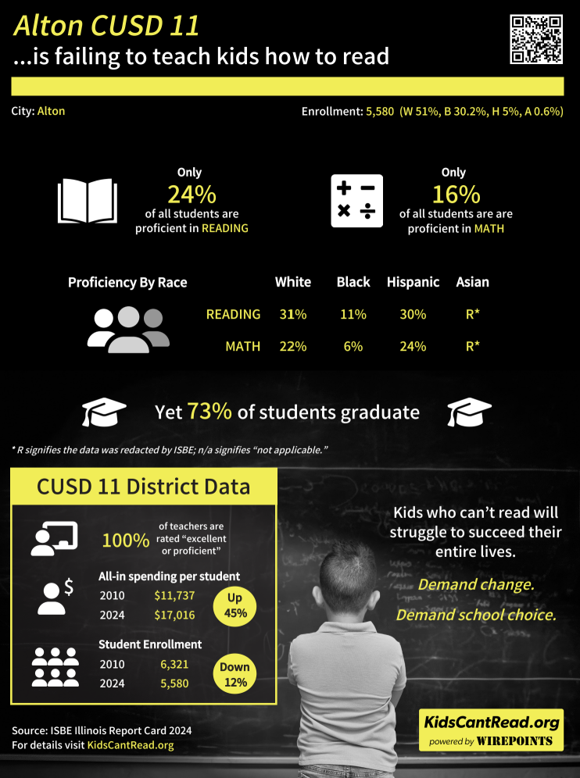Microcosm of Failure: Madison County Public School Students Can’t Read
The National Assessment of Education Progress (NAEP), also known as the nation’s report card, paints a bleak picture of student achievement nationally, but the NAEP and other state assessments drill down to the school district level in critical subjects such as reading and math.
The research organization Wirepoints has documented Illinois’ education failures, the most evident of which have occurred in the Chicago area and have been well publicized. (See Education Reporter, October 2024.) But the problems exist statewide, and an example is the lack of student competency in reading and math at several Madison County, Illinois school districts, located just northeast of St. Louis.
In the Alton Community Unit School District (CUSD) 11, only 24 percent of students are proficient in reading, and just 16 percent are proficient in math. Despite these dismal numbers, 73 percent of students manage to graduate in the district, and 100 percent of teachers are rated “excellent or proficient.” Per-pupil spending in the Alton CUSD 11 increased 45 percent from $11,737 in 2010 to $17,016 in 2024.
 Students in the Highland, IL CUSD 5, fare somewhat better, with an overall proficiency rating of 47 percent in reading and 26 percent in math. Per-student spending in Highland rose from $10,002 in 2010 to $13,953 in 2024.
Students in the Highland, IL CUSD 5, fare somewhat better, with an overall proficiency rating of 47 percent in reading and 26 percent in math. Per-student spending in Highland rose from $10,002 in 2010 to $13,953 in 2024.
In the Roxana Community School District 1, only 30 percent of all students test proficient in reading, and 20 percent are proficient in math.
While each of these districts significantly increased their spending over the 14-year period studied, enrollment declined in all three. In Alton, spending rose 45 percent while enrollment decreased by 12 percent. Per-pupil spending in the Highland CUSD 5 increased 40 percent even as enrollment dropped 10 percent. The Roxana CUSD 1 recorded a whopping 97 percent jump in per-student spending, while its enrollment fell 17 percent.
Obviously, in this microcosm of performance results, the rise in spending did nothing to improve student proficiency in the critical subjects of reading and math.
It is perhaps ironic that student performance is so low in Madison County schools, particularly in reading, given that it was for many years home to the tireless champion of phonics instruction, the prominent author, Republican political leader, and pro-family advocate, Phyllis Schlafly. Phyllis often warned about the folly of abandoning phonics instruction for fads such as “whole language” or the “look-say” method.
Traditional public-school enrollment dropping
In June 2024, the Pew Research Center reported that traditional public school enrollment numbers “have shifted over the last decade,” with many districts experiencing declines. Pew documented that in the fall of 2011, “about 47.2 million students attended public elementary, middle, and secondary schools, accounting for 87% of all school enrollment. By fall 2021, the number of public-school students had dropped to about 45.4 million.” This trend has continued.
One reason for the decline is that many parents are turning to charter schools, as Education Reporter described in June 2022 and January 2024. While they are technically public schools, many charter schools offer what parents consider a better curriculum and classroom environment than traditional public schools. Many charter schools have long waiting lists and require testing and/or written essays to determine admittance.
In Illinois, nearly all the charter schools are located in the greater Chicago area, with a few in Rockford, and about a half dozen one-off charters operating in towns around the state, including the state capital of Springfield. There are no charter schools currently operating in Madison County.
including the state capital of Springfield. There are no charter schools currently operating in Madison County.
Another factor is the growth of both homeschooling and what have become known as microschools. Approximately 3.7 million children are homeschooled, and an estimated 1.5 million more are enrolled in the approximately 95,000 microschools operating in the U.S. as of 2024. Some microschools dovetail with homeschooling.
Pew research further shows that private school enrollment, including parochial schools, has remained relatively steady, with historically about 10 percent of all students enrolled in these schools. It is therefore unlikely that private-schools have played a significant role in the declining public-school enrollment numbers, which have not only occurred in Illinois, but in school districts across the country.
Ultimately, the persistent decline in public-school enrollment, despite hefty spending increases, shows that parents are fed up with the issues plaguing traditional public education, and that throwing more taxpayer dollars at the problems has failed to solve them.
Most parents oppose the propagation of a leftist political ideology, which occurs to a greater or lesser extent depending on the school, even as their children are not learning how to read or do math. They are desperately seeking alternatives that fit with their budgets and lifestyles, and are removing their kids from public schools when they find them.
(Editor’s Note: Some information in this article was provided by Kurt Prenzler, executive director, Phyllis Schlafly Eagles.)
Want to be notified of new
Education Reporter content?
Your information will NOT be sold or shared and will ONLY be used to notify you of new content.
Click Here
Return to Home Page
